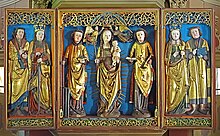St. Laurentius (Graefenroda)
The Protestant village church of St. Laurentius is a baroque hall church in the Gräfenroda district of the Geratal municipality in the Ilm district in Thuringia . It belongs to the parish of Graefenroda in the community network of Graefenroda-Gehlberg in the parish of Waltershausen-Ohrdruf of the Evangelical Church in Central Germany . Johann Peter Kellner worked at this church from 1733–1772 as an organist , from whose environment the toccata and fugue in D minor BWV 565 , commonly attributed to Johann Sebastian Bach , could come.
History and architecture
The church was built as a hall church in the years 1731–1735 by the master builder Johann Erhard Straßburger from Gotha in place of an older predecessor structure and restored in the years 1839–1843. The uniformly built nave stands on a high plinth, is covered with a mansard roof with dormers and ends in an apse in the east, in the west a three-storey square west tower with a bell storey is attached. The church is accessed on the north and south side through a central portal under a curved roof, on the west side of the tower there is a portal in the same shape. The tower has corner blocks and is divided into storeys by cornices, the top, octagonal bell storey is provided with pilaster strips and arched windows and is closed off with a hood and lantern . The interior is finished with a wooden, arched barrel vault and is bordered on three sides by two-storey galleries.
Furnishing
In the east there is an architecturally built pulpit altar from 1735 with figures of Moses and John the Baptist. A winged altar from 1525 shows in the shrine Mary with child and two crown angels, flanked by Saints Laurentius and Stephanus , other saints are depicted on the wings. The figures stand on richly carved pedestals and are crowned by canopies. On the outside of the wings there are paintings depicting female saints: Dorothea and Margareta on the left , Apollonia and Ursula on the right .
organ
The organ with a richly designed prospectus is a work originally by Johann Anton Weise from 1736, which, after several major modifications and a reconstruction according to the original arrangement by the Waltershausen Orgelbau company, today contains 24 registers on two manuals and a pedal . The disposition is:
|
|
|
|||||||||||||||||||||||||||||||||||||||||||||||||||||||||||||||||||||||||||||||||||||||
- Remarks
- ↑ Sesquialter as a preliminary print
- Other registers : Glockenspiel (ac 3 ), cymbal star (6 bells).
- Coupling : manual coupling, coupling pedal - Hauptwerk
- Secondary register and playing aids : tremulant (manuals)
literature
- Georg Dehio: Handbook of the German art monuments. Thuringia. 1st edition. Deutscher Kunstverlag Munich / Berlin 1998, ISBN 3-422-03050-6 , p. 506.
Web links
Individual evidence
- ^ Website of the Johann Peter Kellner Society. Retrieved October 20, 2019 .
- ↑ Information about the organ on orgbase.nl. Retrieved October 20, 2019 .
Coordinates: 50 ° 45 ′ 1.1 ″ N , 10 ° 48 ′ 46 ″ E






